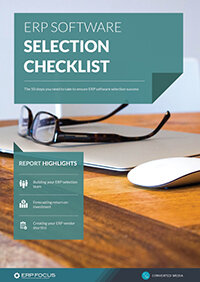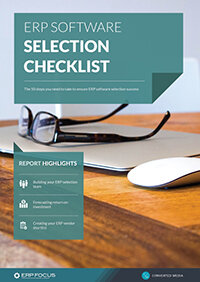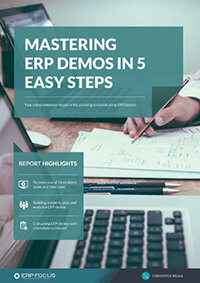ERP selection process (free 5 step ERP selection checklist)
As the average ERP selection project takes around seventeen weeks - you’ll want all the headstarts you can get.
Key rule of project management: when doing something new, ask someone else how they did it before. Yet the problem is, with large-scale software projects like an ERP selection, there’s no guarantee that the person who managed the process is still around.
If you’re at the point where you’re replacing an ERP, the likelihood is that your legacy system has been in place a very long time (unless your company has done something really wrong, in which case you’ve got even more work cut out for yourself…). You’ll need to find another way to get a headstart.
We’ve broken down the ERP selection process down into manageable chunks. This complete ERP software selection checklist covers everything you need to know - and we mean everything.
From deciding that you want to move forward with finding a new ERP for your business to drawing up contracts and service level agreements, we’ve got you covered with quickfire checklists, actionable tips and industry expertise on:
- Identifying the need for new ERP software
- Understanding which features you need
- Crafting, sending out and evaluating RFPs
- Navigating vendor demos and making a final selection decision
Firstly, let's start from the beginning...
What is the ERP selection process?
Selecting the right ERP requires a thorough look at your business requirements; the selection process is a step-by-step plan to find an ERP that meets your current needs as well as future operational and financial needs.
Quick jump to:
- Establish the need to change ERP
- Creating your ERP requirements and finding your stakeholders
- Shortlisting potential systems
- Sending out your RFP
- Evaluating your ERP demos
1. Check for warning signs that ERP change is needed
Why should I select a new ERP?
This is largely dependent on your organization’s circumstances - there is no universal way of telling when your ERP becomes officially out-of-date.
That said, there are some common signals that your ERP no longer suits your needs. If your ERP:
- Was selected before your company expanded into new areas
- Can’t help you meet current compliance needs
- Doesn’t integrate well with the software you need to do business in the 21st century
...it might be time to audit your existing system and start gathering requirements for an upgrade to your ERP.
2. Survey key stakeholders and draw up an ERP requirements list
How do I define my ERP requirements?
Requirements gathering is a lengthy process, so it’s important to approach it methodically.
Don’t dive straight into identifying all the shiny new features you want. Instead, take a step back and:
- Map out key processes that your new ERP should support
- Identify areas where your current ERP is falling short - maybe you have bottlenecks in your supply chain, or it can’t integrate with your e-commerce system
- Forecast your existing growth and the functionality you’ll need to support this. Are you expanding into new markets, for example?
You can then start discussing the features you'll need to be prioritized whilst selecting an ERP system.
Who should be involved in ERP requirements gathering?
At least around 26% of your workforce is likely to be comprised of ERP users. That percentage increases for smaller companies.
Needless to say, a system that lets down a quarter of your workforce is a no-go, so you’ll need to be thorough in surveying your workforce’s ERP needs.
To understand the needs of your organization as a whole, you should carry out an extensive stakeholder analysis. This will ensure your new software addresses the needs of your business as a whole and provide a firm base for user engagement further down the line.
| Stakeholder | Area of interest |
|---|---|
| Senior management | Analytics, BI |
| Department managers | Analytics, BI, department relevant functions, HR |
| Accounts department | General ledger, accounts, asset & cash management |
| Shop floor workers | Document management, inventory, designs |
| Warehouse staff | Inventory, supply chain management, mobile device integration |
A basic example map of stakeholder requirements in a mid-sized organization
Remember: not all your requirements will be process-focused. For example, you may need a system that is mobile compatible, runs on a specific version of Windows or is local to your production plant.
Should I choose cloud or on-premise ERP?
Both cloud and on-premise systems have their advantages - but will suit different companies. The table below outlines some key differences between the two:
Usually, per-person per month with no upfront fee. Vendor hosts software on their servers - you access via the web. No extra required, as long as you have internet access.
| Pricing | Hosting | Security | Hardware | |
|---|---|---|---|---|
| Cloud | Usually per-person per month with no upfront fee | Vendor hosts software on their servers - you access via the web | Taken care of by third party experts | No extra required - as long as you have internet access |
| On-premise | One off license fee for perpetual ownership with no further payments | You host the software on-site on your own servers | Your responsibility. You own the software - procedures are up to you | Your hardware needs to be up-to-date enough to run the software. If it isn’t, you need to replace it |
This article explains the differences between cloud and on-premise ERP in more detail - check it out if you need a more in-depth overview.
Cloud software seems to be the industry trend du jour among tech journalists - and there has been a shift in interest towards the SaaS model from those selecting an ERP. Equally, it’s not a drastic one. Whilst more ERP project managers are actively searching for cloud software than for on-premise (26% vs 16%), the majority (57%) were undecided on deployment model. Newer research shows that 63% of businesses are only considering cloud-based systems.
There’s a pronounced split across industries too:

Distribution’s strong preference for cloud reflects the need for a real-time system that integrates with client and supplier’s systems. Meanwhile, process manufacturing companies’ relative lag in seeking out cloud software could indicate security and compliance concerns specific to the sector.
Whilst cloud is new and exciting - especially so in the ERP space - don’t overfocus on it. If it meets your requirements, great. If not, there’s plenty of excellent on-premise ERPs that will suit your needs.
Will I need an industry-specific ERP?
Short answer: if you need industry-specific functionality, yes. Otherwise, no.
You might be a made-to-order manufacturer, but if all you want from your ERP is an upgrade to Quickbooks and integration with the systems you already have in place there’s little point paying extra for functionality you have elsewhere.
On the other hand, if you do have niche requirements that your ERP must address, industry-specific ERPs are a good route to go down. Generally they will be designed around workflows similar to yours and require less customization to fit your needs.
For more information, take a look at these industry ERP whitepapers - you’ll find information on key vendors and the features their software offers:
- Electronics ERP Buyers' Guide
- Manufacturing ERP requirements template
- Seven steps to selecting distribution ERP
3. Shortlist potential vendors
This is one of the biggest steps during the ERP selection process. There are lots of ERP vendors out there, so whittling them down into a shortlist can seem daunting!
It doesn’t have to be though. There are several ways to get a better idea of vendor suitability:
- Competitor analysis using Datanyze
- Recommendations from your network
- RFIs
- Online community requests
To start with, we’ve created a super-useful ERP comparison tool. You can use this to compare vendors by industry, key features and delivery method. This will give you a more workable number of ERPs to deal with.
Following this, there are several ways to distinguish further between potential vendors:
1. Competitor analysis using Datanyze
This is a very simple premise. If lots of your competitors are using a certain system, it’s highly likely that it will suit your own needs reasonably well.
Obviously you’re going to have your work cut out trying to get your competitors to share their technology strategy with you.
That’s where technographics tools like Datanyze come in, which monitor the technology choices of millions of different companies. They’re often used as prospecting tools by vendors looking for opportunities to sell.
They’re also pretty useful for researching what your competitors are using. As an added bonus, Datanyze has a free trial - so if you’re organized you can make full use of the insights it can provide without having to pay a penny.
- Pros: finds systems that are definitely in use in your industry
- Cons: doesn’t take into account company culture. If you and your competitors both manufacture car parts but your workflows differ, a competitor’s system might not be the best fit.
2. Recommendations from your network
You’ll likely know a lot of people in your industry. Ask recent hires what they used at their last place, for a start. You could also ask suppliers or client companies what they use. You'll likely know someone who has recently been through an ERP selection; leverage your network. Your needs won’t be identical, but they will be able to vouch for how robust the system is, and how efficient their support offering is - as well as pointing out any major red flags.
- Pros: people will provide you with on-the-ground experience of particular ERPs. If a system’s UX isn’t up-to-scratch, this is one of the first things they will mention.
- Cons: hard to tell if these are isolated opinions or not, without seeking out lots of recommendations from the same source
3. RFIs
An RFI (request for information) is a document sent out to vendors to collect further information on them during ERP selection. You send the document out, ask for replies within a certain timeframe and compare your responses.
This is not the same as an RFP (see below for more information). Ideally these should be less detailed than an RFP and used for gathering extra information on a vendor and their product, rather than asking vendors to address specific requirements.
- Pros: as it’s a uniform document, responses can be compared across a predefined set of criteria
- Cons: time consuming. Also, be prepared to receive sales pitches rather than completely objective considerations about whether their system suits your needs
4. Online community requests
Whilst going off the recommendations of some guy on the internet might seem an odd choice, there’s actually a lot to be gained from doing this.
Start with LinkedIn - post on relevant discussion groups asking for input and experiences with the systems you are interested in. Quora is also a useful tool for asking niche software questions to an open audience - though it’s admittedly less targeted than posting in LinkedIn groups.
- Pros: you can survey a much wider range of people online than you can by asking for recommendations face-to-face
- Cons: people commenting on internet posts tend to be motivated to do so by extreme experiences. The feedback you receive will likely be skewed to ‘very good’ or ‘very bad’ rather than anywhere in the middle.
4. Send out an RFP and evaluate responses
When should I send out an RFP?
Once you’ve:
- Created a final list of key software requirements
- Solidified a shortlist of vendors that you think could meet them
...it’s time to start working on an RFP (request for proposal).
In this document, you’ll outline your list of requirements, and allow recipients to explain how their system can meet them. Of course, the better structured and more detailed your RFP, the more useful the responses will be.
How should I structure my RFP?
There are a number of things to include in an RFP. A good basic template to work from is as follows:
| Section | What to include |
|---|---|
| Summary of project purpose | Background on your company, why you want a new ERP, which departments will be using it and general information on what processes it should take care of |
| Project timeline | When you plan on selecting an ERP by, and a goal implementation timeline broken down into key stages |
| Requirements | Include for each requirement: reason you want it, how much of a priority it is for you, which area of the business has the requirement, what it should integrate with, and whether you want it straight out of the box (i.e would long-term development of a customized solution be acceptable?) |
| Vendor qualifications | What you want from the vendor. Include: request for client recommendations, what services you want them to provide, what level of support you’d like, what sort of company culture you expect |
| Proposal evaluation criteria | Let your vendor know how you propose to evaluate their response. This should include a deadline date for the return of responses to your RFP |
If you want a more detailed look at the RFP process, then be sure to check out our step-by-step guide to creating and evaluating ERP RFPs.
How to evaluate RFP responses
It’s important to decide on a uniform set of criteria for evaluating your RFP responses.
Have your selection team read through the RFPs and score each out of five against these criteria. Total these up, and have a meeting to discuss the five highest scoring systems, and aim to whittle this down to a final three to invite to demo.
Remember: the three you invite to demo won’t necessarily be the three highest scoring systems. If your highest scoring ERP doesn’t meet your timescale or vendor culture requirements, you’ll probably want to drop it.
Once you have decided on your final three systems, it’s time to invite them to demo their product.
5. Invite vendors to demo and make a final selection decision
Consider this stage the culmination of the ERP vendor Hunger Games. You’ve eliminated the candidates that don’t perform. Only the strong survive.
You’ll judge them against each other in one final showdown - known in no less exciting terms as the ERP demo stage.
How should software demos be structured?
Firstly, remember this: you are in charge. You're the one selecting an ERP system. They are selling to you. Make sure the way your demos are structured reflects this.
To avoid sitting through sales pitches that won’t give you the insight you need to choose the right ERP for your business, it’s a good idea to draw up a demo script to send to vendors. This will allow you to control the direction of the demo. It’s also
You can find a template software demo script here.
If you want an in-depth rundown of how to get the most out of ERP vendor demos, give our demo guide whitepaper a look - it offers a step-by-step guide to how to plan for demos, who should be on the team and the best ways to evaluate them.
Talking of demo teams, here’s a quick checklist of who you should be inviting to view the demos:
- You (the ERP selection project manager)
- Heads of department
- Representatives from all key user groups
- Your executive sponsor
You should invite representatives from all key user groups as well as their department managers. They will use the ERP in a different way to management, and this should be reflected in the makeup of those viewing the demo.
How to evaluate ERP software demos
Another advantage of providing vendors with scripts is that it provides a uniform format with which to evaluate them.
It’s a similar process to the one for evaluating RFPs outlined above - get your team to score each vendor out of five for how well they meet each requirement. Meet to discuss.
Again, your highest-scoring system might not be the one that you end up choosing - you’ll definitely want to prioritize some requirements over others, for example. You might want to choose an ERP that hits the top scores for your key requirements but has a lower score overall. It’s not an exact science.
Once you’ve found your ideal ERP you’ll need to call your legal team, and enter contract negotiations...but that’s another topic for another article.
For now, take a breather and congratulate yourself on getting through the first part of your ERP replacement project.
Bonus: ERP selection checklist
We've compiled a list with the key steps you need to take prior to selecting your ERP - every step in the process so you don't miss anything. You can also download the full 60-step checklist for selecting ERP.
Prior to ERP selection
Rushing through the ERP selection process without investing time into assessing whether your system meets your business needs is a guaranteed way to ensure your project fails. Before selecting your preferred ERP, you should at first consider the factors listed below.
- Have you selected an ERP selection project lead?
- Will you supplement your ERP selection team with any consulting expertise?
- If yes, have you identified the role an ERP consultant will play in the selection process?
- Have you received references from the consultant’s previous clients?
- Which C-level individual will be your executive sponsor for the project?
- Are your ERP requirements documented in an accessible and detailed format?
- Are your ERP requirements a fair representation of all departmental needs?
- Have prospective ERP users had a say in the requirements gathering process?
- Are your requirements prioritized?
- What is the expected monetary value of meeting these requirements?
- Will this return on your investment be enough to satisfy senior management?
- Is there a non-economic reason dictating your ERP choice?
- Are those reasons in writing and is there agreement from all departments?
- Do you have any ERP integration requirements?
- Are you looking for cloud or on-premise software?
- What are your ERP requirements for mobile devices?
- What languages and currencies must your new ERP support?
- What support level do you require from either your vendor or a third party?
- What ERP training do you require from either your vendor or a third party?
- Have you received any references from other businesses in your industry?
- Have you drawn up a shortlist of potential ERP systems?
Industry ERP choices
Different business types will have different requirements when it comes to selecting an ERP software. It's vital to consider what your business niche needs to operate effectively; what a fashion retailer requires will be vastly different from a 3PL business. Here are a few industry ERP choices you may consider.
Manufacturing specific:
- Where do you need visibility in your supply chain?
- Is it time to integrate a manufacturing execution system?
- How will machine to machine communications help your ERP system?
- What business intelligence tools are you looking to use?
- Is now the time to integrate automation systems such as pick to light or voice picking?
- Do you need to connect your measurement tools to record directly in your ERP database?
B2C businesses and retailers
- Do you require CRM in your ERP?
- Do you need to link to your customers’ systems for downstream visibility to demands?
- Should your customers be able to place orders directly using eCommerce?
Relevant to all business types
- What quality control requirements will you ERP have to support?
- Which areas of wastage are you looking to reduce with a new ERP system?
- What compliance requirements does your business have and how will ERP meet these?
- Is the user interface modern tiles or old-style drop down menus?
- How difficult is it to change the words in the standard interface?
- Will the ERP support all the languages you use?
Post-ERP selection
Once you've satisfied the above criteria, it's time to address your selected ERP system. Not many businesses will be able to work with an ERP out of the box, there will likely be some customization needs. Consider some factors below:
- Can you use your selected ERP as-is?
- What will the hardware requirements be for your selected ERP?
- What is the condition of your existing network?
- Will you need to add any staff to manage your selected ERP?
- What is the predicted total cost of ownership of your selected system?
Selecting a new ERP is a complex process with many variables being fed into one end of the funnel, and only one system coming out the other end. This ERP selection checklist covers some of the questions you need to be asking yourself prior to ERP selection as well as post-ERP selection. Also covered are a range of industry-specific ERP selection decisions which need to be made to ensure your ERP selection process goes smoothly.
Free white paper

60-Step ERP Selection Checklist
Get the comprehensive checklist for your ERP selection project

Featured white papers
-

ERP Software Pricing Guide
Get the latest pricing information on over 80 popular ERP systems, and learn how to budget for your ERP project in our free guide
Download -

60-Step ERP Selection Checklist
Get the comprehensive checklist for your ERP selection project
Download -

ERP Demo Guide & Scorecard
Master your ERP demo with 5 easy steps using our free guide (includes demo scorecard)
Download
Related articles
-

The best ERP systems for process manufacturing
Consider these ERP systems when selecting your next process manufacturing ERP
-

Secret KPI: Why Your ERP Implementation Team Matters More Than Software
Learn how Godlan ensures successful ERP implementation for manufacturers with proven strategies &...
-

5 ERP pricing definitions you need to understand
Have you mastered the ERP pricing lexicon yet? Getting to grips with these five definitions is a ...

